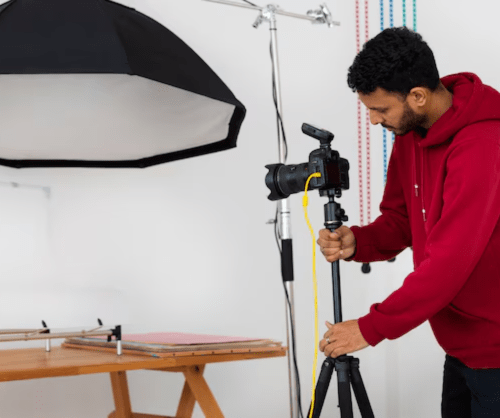
In terms of stills and moving images today, technology shapes the modern world of photography and videography significantly, opening up new ways of working that continuously give new perspectives on creativity and efficiency. We are very much aware of how much of a difference these innovations can make in the industry; hence, we at Alamelu Studios have tried our utmost to give birth to a fully-fledged outfit that will provide the best of the best for the professional as well as the lover of everything animation! In this article, we tried to have a look at how big a revolution modern-day technology has brought upon photography and videography, why these are some key changes, and their implications for content creators.
The digital camera, along with the smartphone armed with robust camera features, has brought a rejuvenation to the world of photography and filmmaking.
Film to digital cameras
We have talked about change in the photography and videography worlds. There are a number of advantages to digital cameras over film cameras, including the ability to shoot an image for as long as your card or camera will permit, review them on the spot for evaluation of exposure and composition, etc.
Key Innovations:
- DSLR and Mirrorless Cameras: Digital Single-Lens Reflex (DSLR) and mirrorless cameras are now popular, standard production quality standards that come with versatility, top-notch image quality, and simplicity to use, making them the perfect choices. These cameras have interchangeable lenses, giving photographers and videographers the opportunity to choose the right lens for each situation.
- High Resolution: The high resolutions of modern digital cameras allow creators to capture minute detail with amazing precision. We regularly see 4K and 8K video resolutions, delivering videos with ultra-high-definition quality that bring the viewing experience to the next level.
- Faster and Longer Continuous Shooting: With the newer sensor technology, you can take faster continuous shots without overheating issues, which was common in earlier models, and run the cameras almost continuously for many days without being worried about the camera failing.
Smartphones democratise stills and videos.
For periods of time, smartphones have done a great job of making photography, especially videography, more mainstream and accessible. Today’s mobile devices have incorporated advanced camera systems and sensors and the ability to enhance the quality of images and videos in real time and offline, which gives modern devices the ability to capture professional-quality images and footage.
Key Innovations:
Computational Photography: Mobile phones incorporate computational photography to improve image data. This technology involves making different shots to be taken in a single high-quality shot, enhancing the contrast, and also covering all the areas required by the phone for the creation of a portrait mode and a night mode.
- AI and Machine Learning: Enhancements that come with AI and machine learning include auto-adjusting settings such as camera aperture, identifying scenes and scenes, and real-time enhancing, thus giving the impact of professional photography and videography.
- 4K Video Recording: Recent smartphones offer 4K video features with stabilised images, which may be equal to ordinary cameras.
Drones: Expanding Creative Horizons
Some of the major uses of drones include the technology of photography as well as videography, which has been revolutionised by drones since they enable people to capture images and videos in areas that would have been hard or even impossible to reach. Shooting from a bird’s-eye view provides the audience with broad views of landscapes, structures, and even the motions of busy cities and powerful, fast-moving actions.
Key Innovations:
- Stabilisation Technology: Additional stabilisation is used in gimbals, which makes the video smooth and stable irrespective of the situation, including the presence of wind or when one is moving briskly.
- Autonomous Flight Modes: The latest drones feature a set of built-in autonomous options like follow-me, orbit, waypoint, etc., therefore leaving only the most creative shots to be taken manually.
- High-Resolution Cameras: State-of-the art quadcopters have mountings to accommodate high-definition cameras with specified resolutions, frequently up to 4K or even 8K, and add incredible detail to aerial shots.
Post-Production Software: Fine Tuning of Creative Works
Software post-production is a critical element in contemporary photo and video production since it enables the artist to refine the reception of materials and transform the footage or images into a definitive final product.
Key Innovations:
- Non-Linear Editing (NLE) Software: Adobe Premiere Pro, Final Cut Pro, and Davinci Resolve are famous non-linear editing software that gives control in fine editing videotape, colouring, and even some effects.
- Photo Editing Software: Freeware photo editors like GIMP and PaintShop Pro Pro provide users with an extensive range of options for post-processing, image retouching, colour correction, and composing all in one place.
- AI-Powered Tools: Trimming includes erasing objects, replacing backgrounds, and facial smoothing, among others, which can be among the time-consuming steps in post-production software enhanced through AI.
- Virtual Reality (VR) and Augmented Reality (AR): Incorporation of Experiences
Artificial Intelligence (AI) and Machine Learning: Applied Creativity
Now we can observe how artificial intelligence and machine learning make great contributions to such fields as photography and video production by providing tools and features that can help unleash one’s creativity and make work easier.
Key Innovations:
- Automated Editing: Various software powered by A. I could be used for selection of the best shots, cutting, and even for improvement suggestions, thereby bringing down the overall effort for the video creators.
- Intelligent Image Recognition: This can also indirectly facilitate organisation and searching through large volumes of content by tagging them as pictures and videos.
- Enhanced Creativity: AI tools offer innovative ideas, and here is the creativity applied, which is called style transfer, where one image is given the style of the second one.
- Live Streaming and Real-Time Broadcasting: Informing and Interacting with the Public
Live Streaming and Real-Time Broadcasting: Public Relations
Live streaming has now become a significant factor in the contemporary video production since it helps people perform real-time performances for users. It has been integrated into various platforms ranging from casual social media platforms, social group and professional broadcasting.
Key Innovations:
Live Streaming Platforms: There is a section of online streaming services such as Youtube Live, Facebook Live, and Twitch that allow easy streaming of live content to the universe.
- Real-Time Interactivity: Social networks integrated into live streams include a live chat with the option of sending comments, questions, polls, and Q&A sessions.
- Mobile Live Streaming: From the choice of the word ‘virtually’ here, this means that advancements in mobile technology and high definition enable live video streaming from anywhere, thereby enhancing its accessibility and flexibility.
Professional Audio Equipment: Guaranteeing Good Standard Sound
Audio is vital for the production of successful professional videos, and technology has continued to enhance crispness and sound quality.
Key Innovations:
- Directional Microphones: A shotgun microphone, also known as an aerial microphone or a boundary microphone, is intended for picking out sounds in particular directions, reducing all the noise and adding to the clarity of the voice, which is similar to the lavalier microphones.
- Wireless Audio Systems: Freedom of mobility is achieved in a wireless microphone since this system allows participants to move around as they record their statements.
- Audio Post-Production: Adobe Audition and Pro Tools are post-production software tools that serve to improve audio quality and increase productivity by providing more developed functions for noise elimination, sound blending, and equalisation
Conclusion: Transcending Tradition and Modernity at Alamelu Studios
Alamelu Studios knows well enough, and therefore it understands that technology changes the ways in which photography and videography are done. The main focus of our company is to offer our clients state-of-the-art technology that will enable them to express their creativity while making their art.
At our studio located in Delhi, NCR, we have imported the best cameras, imported lighting equipment, and high-quality audio recording and playback devices, along with an advanced range of software and tools required for post-production work. Whether you are a professional artist, an artist who is still occurring, or an art lover, Alamelu Studios will provide a platform for the realisation of various artistic creations.
They can only hope for the best in the future as technology emerges to create more and more possibilities in the field of photography and videography. We do not strive to provide our clients with average services. By offering reliable services in the latest technologies and applications, we will ensure that our clients get the highest and most updated technologies as we find them. So come and join our community of artists at Alamelu Studios, where art meets technology, and let us conceptualise something unique.
